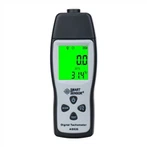How do you measure integrated circuits using a multimeter to test?
There are ways to replace integrated circuits, but it is troublesome to disassemble them. Before disassembling, you should determine whether the IC is really damaged and the degree of damage to avoid blind disassembly. Measurement of DC resistance, voltage, AC voltage and total current are the four methods of on-line detection of integrated circuits with a multimeter.
(1) not online detection.
This method is carried out when the IC is not welded into the circuit, generally available multimeter to measure the pins corresponding to the ground pin between the positive and negative resistance value, and the intact IC for comparison.
(2) On-line testing.
This is a testing method to detect the DC resistance, AC/DC voltage to ground and total operating current of each IC pin online (IC in circuit) by multimeter. This method overcomes the limitations of the replacement test method, which requires a replaceable IC, and the trouble of disassembling the IC, and is the most commonly used and practical method for testing ICs.
① On-line DC resistance detection method: This is a method to measure the positive and negative DC resistance values of IC pins and peripheral components directly on the circuit board with the ohm stop of a multimeter and compare them with the normal data to find out and determine the faults. When measuring, the following three points should be noted: a. Disconnect the IC before measurement.
a. Disconnect the power supply before measurement to avoid damaging the meter and components during testing.
b. The internal voltage of the multimeter resistor should not be greater than 6 V, and the best range is R×100 or R×1 K. c. When measuring the parameters of IC pins, it is better to use R×100 or R×1 K to measure the parameters of IC pins.
c. Measurement of IC pin parameters, pay attention to the measurement conditions, such as the model under test, and IC-related potentiometer sliding arm position, etc., but also consider the peripheral circuit components.
② DC voltage measurement method: this is a power on, with a multimeter DC voltage block on the DC power supply voltage, the peripheral components of the working voltage measurement method; detection of IC pins on the ground DC voltage value, and compared with the normal value of the compression of the scope of the problem, to find out the damage to the components. Measurement should pay attention to the following eight points.
a. Multimeter to have a large enough internal resistance, at least 10 times greater than the resistance of the circuit under test, so as not to cause large measurement errors.
b. Usually turn the potentiometer to the middle position, if it is a TV set, the signal source should be a standard colour bar signal generator.
c. Meter pen or probe should take anti-slip measures. Because any instantaneous short-circuit is easy to damage the IC, can be taken as follows to prevent the pen from slipping: take a piece of bicycle valve core on the tip of the pen, and the length of the pen tip 0.5 mm or so, which not only can make the tip of the pen good contact with the test point, but also effectively prevent slippage, even if it touches the neighbouring points will not be short-circuited.
d. When the measured voltage of a pin does not match the normal value, the voltage of the pin should be based on the normal operation of the IC has no significant impact on the other pin voltage and the corresponding changes in the analysis, in order to determine the good and bad IC.
e. IC pin voltage will be affected by peripheral components. When the peripheral components leakage, short-circuit, open-circuit or change value, or the peripheral circuit is connected to a variable resistance potentiometer, the potentiometer sliding arm is located in a different position, will make the pin voltage change.
f. If the IC pin voltage is normal, it is generally believed that the IC is normal; if the IC part of the pin voltage is abnormal, it should be deviated from the normal value of the largest place to start, check the peripheral components for faults, if there is no fault, the IC is likely to be damaged.
g. For dynamic receiving devices, such as TV sets, the IC pin voltage is different when there is no signal. If it is found that the pin voltage should not change, but instead of changing greatly, the signal size and adjustable components with different positions but unchanged, it can be determined that the IC is damaged.
h. For devices with multiple operating modes, such as VCRs, the IC pin voltages are also different in different operating modes.






